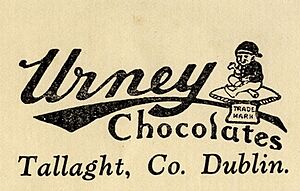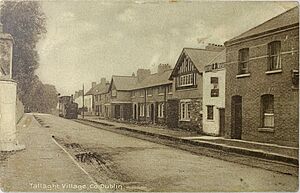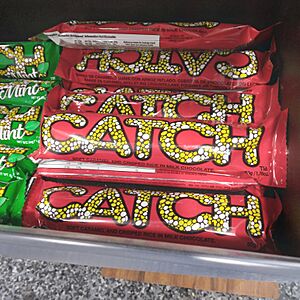Urney Chocolates facts for kids
 |
|
| Public | |
| Industry | Confectionery |
| Fate | Original factory closed 1980, brand sold on |
| Successor | Hazelbrook Confectionery (after L.C. Confectionery) |
| Founded | 1919 |
| Headquarters | Urney, County Tyrone (1919-1924) Tallaght, Dublin (1924-1980) Brand successors - Newbridge, County Kildare (1980 to date), Trinidad and Tobago (ABI - Catch) |
|
Key people
|
Eileen Gallagher Harry Gallagher Redmond Gallagher |
Urney Chocolates was a famous Irish company that made sweets and chocolates. It was started by the Gallagher family in County Tyrone, Ireland. At one point, their factory was one of the biggest chocolate factories in Europe! The company was later sold and the original factory closed in 1980. Today, the Urney brand is managed by Hazelbrook Confectionery in County Kildare, Ireland.
Contents
History of Urney Chocolates
How Urney Chocolates Started
Urney Chocolates began in 1919. It was founded by Eileen Gallagher and her husband, Harry, at their home called Urney House. This was in the area of Urney, County Tyrone. Harry Gallagher worked as a lawyer for the government.
After WW1, many people were leaving the area to find work. Eileen Gallagher wanted to help. She started a garden to grow fruits and berries. Soon, she began making jams from these fruits. Her home's cellar became a busy place for this small business.
To get enough sugar for her jam business, Eileen needed to make other sweets. So, she started making small amounts of raspberry fudge. This was done using simple kitchen tools. The business grew quickly. Within a year, they had 20 helpers.
In 1920, a fire destroyed Urney House. This stopped production for a while. But the Gallaghers quickly built a new small factory. They started making chocolates again. An advertisement in The Irish Times in 1921 announced their return. It said the new Urney chocolates were "better and more delicious than ever."
When the new Irish Free State was formed in 1922, Harry Gallagher's job changed. He then focused on Urney Chocolates. He made it a proper company and became its chairman. Eileen was also a director.
Moving to Tallaght
Urneys was the only chocolate maker in Ireland in the 1920s. They used many Irish ingredients and promoted this in their ads. This made them very popular in what is now the Republic of Ireland. However, they faced challenges in Northern Ireland.
After a second fire at their factory, the Gallaghers decided to move. They chose to go to Dublin instead of rebuilding in County Tyrone. In 1924, the company moved to Tallaght, a rural area near Dublin. They used an old RAF airfield site.
Many of the original 25 female employees, a carpenter, and two maintenance men moved with the company. The old machines were moved 160 miles to Tallaght. New equipment was also bought. There was plenty of space, and homes were provided for the workers. The Gallagher family even lived in the old hospital building, which they called Urney House.
Tallaght village was very small then, with only about 300-400 people. Most families eventually had someone working at the factory. Some Urneys staff traveled daily from towns like Blessington and Hollywood, County Wicklow.
At first, the Gallaghers found it hard to get money for a freezing plant. So, they made chocolates at night when it was cooler. In 1926, electricity came to the factory. They used old generators that used to power the town of Thurles.
Harry Gallagher loved gardening. He used the factory grounds to grow flowers, trees, and vegetables. He also kept beehives. By the early 1930s, the old airfield looked like a beautiful garden. People would even visit from Dublin city to see it. Harry also raised cattle and horses.
Urneys During World War II
Ireland stayed neutral during World War Two (called The Emergency in Ireland). This meant Urneys had to find new places to get their ingredients. For example, cocoa beans came from Brazil instead of West Africa. Glucose came from Canada instead of the Netherlands. These shipments were risky but the company never lost any.
During the war, Britain stopped importing chocolate from outside its currency area. Ireland was still in this area, which helped Urneys a lot. The company started selling chocolate ingredients like chocolate crumb to British chocolate makers. Britain didn't have enough sugar and milk because of the war.
Urneys bought a used German production line to make milk chocolate blocks. They copied it to double their production. The war period was a time of big growth for the company. They bought more machines and even used old whiskey stills to process milk.
Even with food rationing in Ireland, Urneys kept making chocolate. This was because their sugar allowance was based on their busiest time. In 1943, the company was found to have sold extra sugar to other sweet makers.
After the war ended in 1945, rationing continued in Britain. Urneys kept exporting chocolate ingredients and sweets. This peaked in 1953. But in 1954, rationing ended, and Britain started making its own chocolate ingredients.
After the War
After the war, people in Ireland and Britain wanted new and exciting chocolates. Urney products seemed less interesting. To find new customers, Redmond and Harry Gallagher started selling chocolates to the US. They sent wrapped sweets and small chocolate eggs. Urneys also exported chocolate crumb to Lowneys, a big sweet company in Massachusetts.
In the 1950s, an advertising agency created the slogan "Anytime is Urney Time". This became very famous across Ireland and helped the brand.
In 1956, Eileen Gallagher brought back fertile turkey eggs from the USA. She successfully hatched them and raised a large flock of turkeys on the factory grounds. They produced 3,000 turkeys a year for the Irish market. This helped the company's income. Staff also got fresh turkey meat in the factory canteen and free turkeys at Christmas.
Peak Production Years
In 1958, Tommy Headon joined Urneys as a business partner and managing director. Redmond Gallagher took over as chairman from his father. By the 1960s, Urney Chocolates and its related companies employed almost 1,000 people. The Tallaght factory was one of the biggest chocolate factories in Europe.
By 1960, the company bought Devlins of Cork Street, Dublin. Devlins was a toffee maker and the largest children's sweet company in Ireland. Urneys kept their factory, workers, and products, including their popular 'sweet cigarettes' with collectible cards.
In 1961, Urneys took over an English sweet company called Murch. They moved Murch's machines to the Tallaght factory. In 1963, Urneys sold half of its shares to W.R. Grace & Co., a large company from New York. This company already owned Van Houten's Cocoa, a well-known Dutch chocolate maker. This partnership could help Urneys sell its products in the US, Canada, Europe, and South America. Soon after, the UK part of the Van Houten factory moved its production to Tallaght. In 1964, W.R. Grace & Co. also bought HB Ice Cream, a famous Dublin company. Sadly, in 1966, Tommy Headon died suddenly.
To get ready for joining the European Common Market and to grow, Urneys invested £500,000 to update the Tallaght factory. In June 1975, the Taoiseach (Ireland's Prime Minister) Seán Lemass officially opened a new part of the factory.
Harry Gallagher and Eileen, the founders, passed away in 1975 and 1976. In 1977, Redmond retired. Tallaght also started to grow rapidly with many new houses being built.
Decline and Closure
In the late 1960s, sugar prices went up, and there was more competition from snack foods. This meant some jobs had to be cut. W.R. Grace & Co. eventually bought all the shares of Urney Chocolates. In 1973, Grace & Co. sold the Urney/HB business to Unilever. Unilever wanted the HB ice-cream part, but they didn't really want the chocolate factory.
In 1974, Unilever told employees they would run the chocolate factory for five more years. They said they would then "make a decision" because chocolate wasn't their main product. In 1976, Unilever launched the successful Catch bar, which is still made today.
However, Unilever decided to stop making sweets and focus on supplying ingredients. In August 1980, the Tallaght factory finally closed. The 300 remaining employees received a very good redundancy package. The land where the factory stood was very valuable.
Other small factories took over the large building. The factory's machines were sold at auction, mostly to international buyers. An Irish company bought some equipment to make specific sweets, but it also closed in 1985. The old Urney factory later became a DIY store.
What Happened Next
As of 2010, the Urney Chocolates brand was run by L.C. Confectionery Ltd. This company was owned by Leo Cummins and had a factory in Newbridge, County Kildare. Their chief chocolate-maker, Jim Collins, started working at Urneys in 1970.
As of 2021, Catch bars are made by a company in The Republic of Trinidad and Tobago. They are sold in over twenty countries around the world, including Ireland.
Working Life at Urneys
Harry Gallagher believed in taking good care of his workers. In the early days, Urneys was the only big employer in Tallaght village. The village was very small, with just a few shops and houses.
From the start, staff had fun activities and clubs. This was important because the factory was in a quiet, rural area. Factory life created a strong community feeling, as many staff lived nearby or even on site. There were grounds for games, a reading room, a library, and halls for concerts and plays.
Clubs included The Urney Sports and Social Club, a swimming club, and football teams. They also had quiz nights and trips to places like the River Shannon. Once a year, there was a dinner dance where women received a box of Tara chocolates made at the factory.
The Urney Variety Group started in the early 1970s. They put on shows for staff in the factory clubhouse, raising money for charity. This group was very popular and traveled to participate in talent shows. They also performed for children from local orphanages at Christmas. On Friday afternoons, staff could buy "throwouts"—1lb packs of broken chocolates and sweets that didn't pass quality control—at a lower price.
Many staff at Urneys were religious. After lunch, they would visit a statue of the Virgin Mary in the canteen to say prayers. Many also went on group trips to Lourdes in France.
Comedian June Rodgers, who grew up in Tallaght, remembers working at a summer job next to Urneys. She said Urneys staff would give her and her sister chocolate.
Branded Products
- Catch bar
- Urney Anytime Assortment
- Urney Two and Two
- Hadji Bey's Turkish Delight



